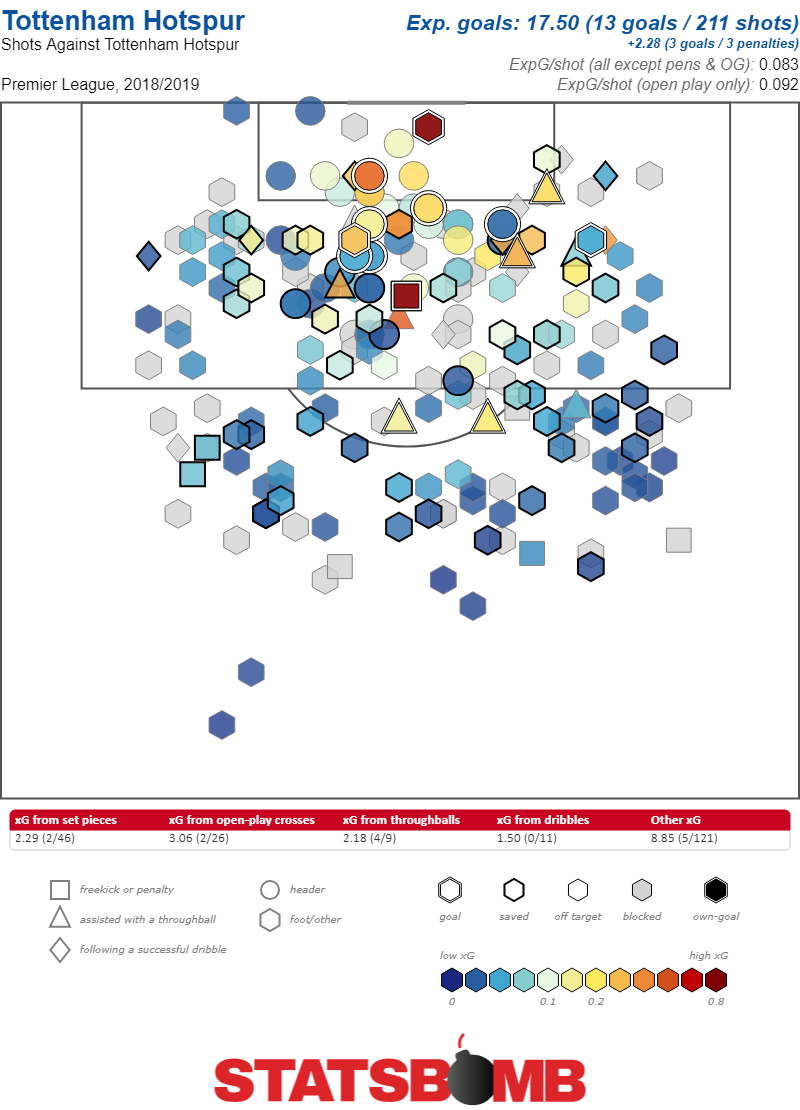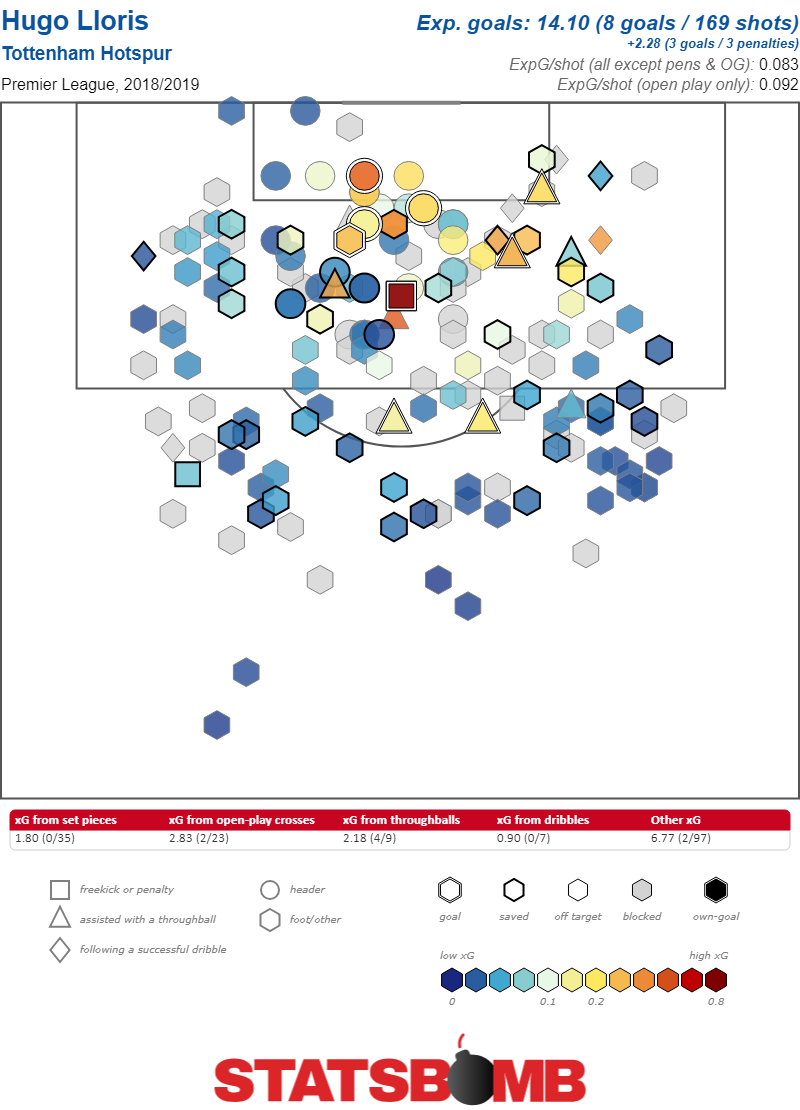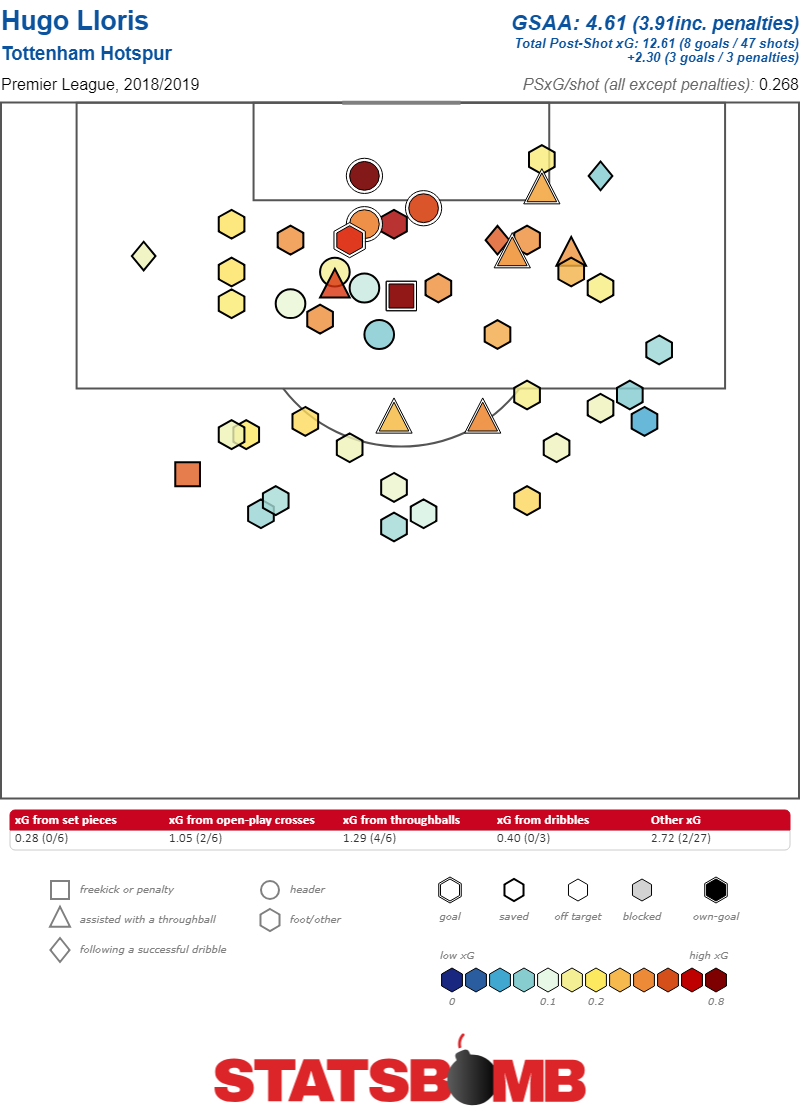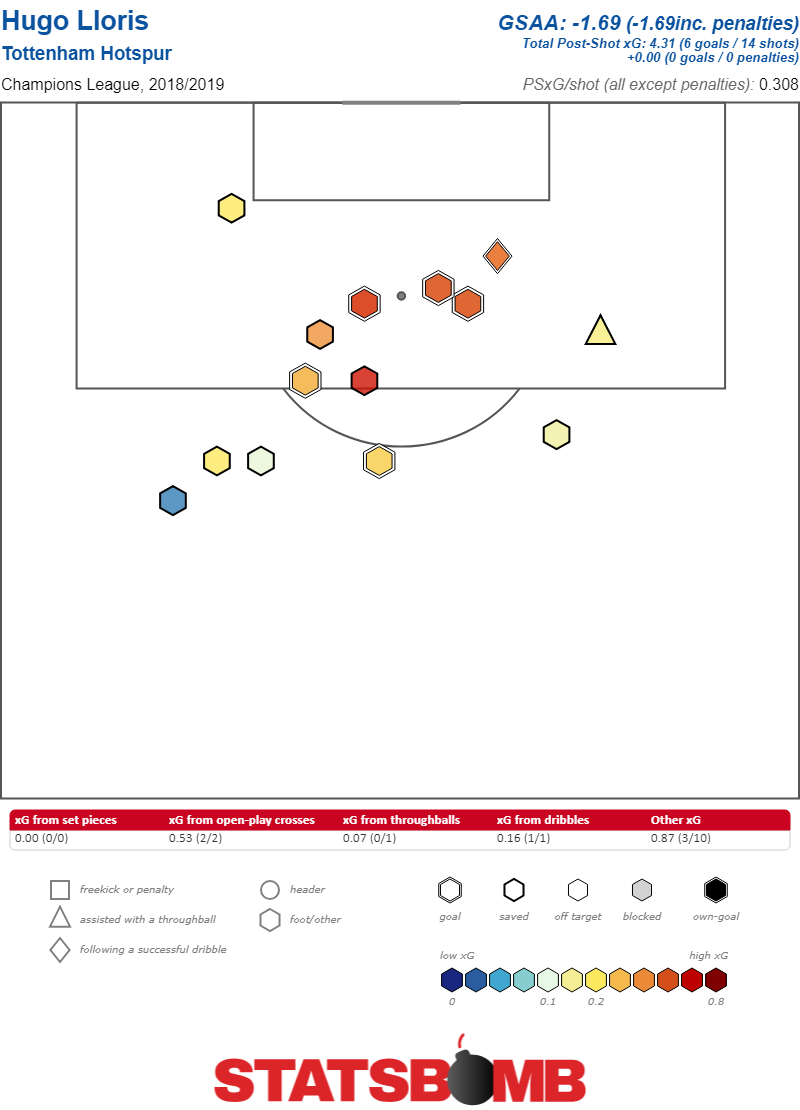There were reasons to be worried about Hugo Lloris. He’s 31 years old. Last season, especially down the stretch, he appeared to be exceedingly mediocre. Early this season he was arrested for drunk driving, an incident that’s on field implications are secondary to its off field ones, but one which nevertheless could conceivably have had on field implications. And yet, Hugo Lloris remains a stalwart in goal for Tottenham Hotspur. On one level this isn’t an argument about numbers. Tottenham’s defense has not been up to their usual standards this year. It’s not controversial to argue that the aging of Mousa Dembele, long term injury to Victor Wanyama, lack of development (and short term injuries) of Eric Dier, and lack of summer recruitment left Spurs dreadfully thin in the center of the pitch. Harry Winks and Moussa Sissoko may have their uses, but those uses don’t include being at the heart of one of the best defenses in the Premier League. Similarly, the Spurs back line has suffered through a seemingly endless string of injuries. Jan Vertonghen, and Davinson Sanchez both continue to be in and out of the lineup, which pushed youngster Juan Foyth to the fore, before he too was hurt. Danny Rose and Ben Davies have both missed stretches at left back as have Kieran Trippier and Serge Aurier on the right. Spurs have been kind of a mess this year. Despite that, they haven’t really conceded very many goals. The 16 goals they’ve given up is fourth best in the league (a brief aside to note Lloris missed four games through injury so Spurs stars are not identical to Lloris’s stats, but we’ll drill down to his specific numbers in a moment). The bottom line here is that despite having a midfield and defense that struggled for consistency, Spurs defense record remained strong. The obvious place to look for reasons why is the keeper. Or, to put it slightly more technically, Spurs are significantly outperforming their expected goals conceded tally. Excluding penalties, their opponents have 17.50 expected goals and only 13 goals actually scored.  Now, let’s look at Lloris specifically. When he was on the field, basic xG has Spurs well overperforming defensively.
Now, let’s look at Lloris specifically. When he was on the field, basic xG has Spurs well overperforming defensively.  Looking at post-shot xG we see a slightly lower xG total but with Lloris still performing well above average.
Looking at post-shot xG we see a slightly lower xG total but with Lloris still performing well above average.  What exactly does that mean? It means that actually the shots against Lloris were slightly easier than a generic xG model predicts they would be. So, somewhat fewer belters towards the corner for Lloris to lunge and tip over, or a couple fewer perfectly placed curlers, and a few more smashed right at him. But that said, Lloris has still saved over 4.5 goals more than an average keeper would have given the shots he’s faced. In fact, as a rate instead of a raw number, Lloris ranks second in the league at Goals Saved Above Average. His GSAA% of 9.8% is only behind Alisson’s 10.7% among first choice Premier League keepers. In the 13 games Lloris has played this year he’s been a huge factor in a very successful Spurs season. The Champions League, of course, is a slightly different story. He played three full matches, and was red carded in a fourth. And his overall performance was below average. His GSAA was below par, letting in 1.69 shots more than a keeper might have on average.
What exactly does that mean? It means that actually the shots against Lloris were slightly easier than a generic xG model predicts they would be. So, somewhat fewer belters towards the corner for Lloris to lunge and tip over, or a couple fewer perfectly placed curlers, and a few more smashed right at him. But that said, Lloris has still saved over 4.5 goals more than an average keeper would have given the shots he’s faced. In fact, as a rate instead of a raw number, Lloris ranks second in the league at Goals Saved Above Average. His GSAA% of 9.8% is only behind Alisson’s 10.7% among first choice Premier League keepers. In the 13 games Lloris has played this year he’s been a huge factor in a very successful Spurs season. The Champions League, of course, is a slightly different story. He played three full matches, and was red carded in a fourth. And his overall performance was below average. His GSAA was below par, letting in 1.69 shots more than a keeper might have on average.  And similarly, last season Lloris put up mediocre results against expectation for Spurs in net. He conceded almost exactly at hist GSAA average. An interesting note about Lloris’s year over year performance is that his expected save percentage was remarkably similar last season, 73.8% to this, 73.2%. That means that his improvement this season is accurately captured by his raw save percentage number in creasing from 73.4% to 83%. It also gives us a little more information about the contours of Spurs decline in defensive performance, namely that it’s a volume issue, and sure enough Spurs are giving up more than 2.5 shots per game more this year, 12.41, more than last year, 9.87
And similarly, last season Lloris put up mediocre results against expectation for Spurs in net. He conceded almost exactly at hist GSAA average. An interesting note about Lloris’s year over year performance is that his expected save percentage was remarkably similar last season, 73.8% to this, 73.2%. That means that his improvement this season is accurately captured by his raw save percentage number in creasing from 73.4% to 83%. It also gives us a little more information about the contours of Spurs decline in defensive performance, namely that it’s a volume issue, and sure enough Spurs are giving up more than 2.5 shots per game more this year, 12.41, more than last year, 9.87  So, how to reconcile all this. The easy thing to say is that this season in the Premier League Lloris has been excellent, at a time when Spurs needed him to be. Projecting that performance out into the future is harder. Part of this is because this data is so new, we don’t know how it is supposed to behave. We don’t know, for example, if the fact that Lloris was so far above expectations last year was in fact a red flag indicating that maybe he was performing at a level that couldn’t continue (similar to how great goal scorers, even if they might be expected to marginally outperform regular old xG, don’t do so consistently by nearly as much as they do in their best moments). Or, maybe actually Lloris consistently has outperformed his GSAA for years and years and years and we just don’t have the historical data that shows us that. Maybe last year was the anomaly, and not only do keepers frequently diverge from GSAA, but they do it in really sustainable ways over large swathes of their career. If that was the case, and last year was the weird one, then there’d by absolutely nothing for Spurs to worry about at all. This season, with all the shot stopping, would just be a return to business as usual. There’s a considerable amount of uncertainty around Lloris, and consequently around the rest of Spurs Premier League season. But, one thing that we can say for sure is that in the thirteen games he’s played this year he’s been excellent, almost as good as any keeper in the Premier League. And Spurs have needed him to be. Without Lloris, Spurs strong start to the season wouldn’t have happened. The question now is will Lloris slow down, and will Spurs be able to keep thriving if he does? Header image courtesy of the Press Association
So, how to reconcile all this. The easy thing to say is that this season in the Premier League Lloris has been excellent, at a time when Spurs needed him to be. Projecting that performance out into the future is harder. Part of this is because this data is so new, we don’t know how it is supposed to behave. We don’t know, for example, if the fact that Lloris was so far above expectations last year was in fact a red flag indicating that maybe he was performing at a level that couldn’t continue (similar to how great goal scorers, even if they might be expected to marginally outperform regular old xG, don’t do so consistently by nearly as much as they do in their best moments). Or, maybe actually Lloris consistently has outperformed his GSAA for years and years and years and we just don’t have the historical data that shows us that. Maybe last year was the anomaly, and not only do keepers frequently diverge from GSAA, but they do it in really sustainable ways over large swathes of their career. If that was the case, and last year was the weird one, then there’d by absolutely nothing for Spurs to worry about at all. This season, with all the shot stopping, would just be a return to business as usual. There’s a considerable amount of uncertainty around Lloris, and consequently around the rest of Spurs Premier League season. But, one thing that we can say for sure is that in the thirteen games he’s played this year he’s been excellent, almost as good as any keeper in the Premier League. And Spurs have needed him to be. Without Lloris, Spurs strong start to the season wouldn’t have happened. The question now is will Lloris slow down, and will Spurs be able to keep thriving if he does? Header image courtesy of the Press Association
2018
Hugo Lloris Is Still Very Good
By Kevin Lawson
|
December 21, 2018
